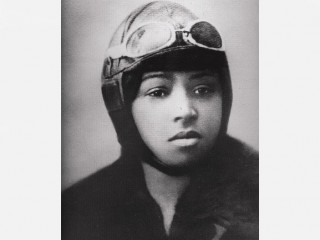
Bessie Coleman biography
Date of birth : 1892-01-26
Date of death : 1926-05-01
Birthplace : Atlanta, Texas, U.S.
Nationality : American
Category : Famous Figures
Last modified : 2010-09-01
Credited as : Aviator, ,
17 votes so far
Early life
Bessie Coleman was born on January 26, 1892, in a one-room, dirt-floored cabin in Atlanta, Texas, to George and Susan Coleman, the illiterate (unable to read and write) children of slaves. When Bessie was two years old, her father, a day laborer, moved his family to Waxahachie, Texas, where he bought a quarter-acre of land and built a three-room house in which two more daughters were born. In 1901 George Coleman left his family. Bessie's mother and two older brothers went to work and Bessie was left as caretaker of her two younger sisters.
Education for Coleman was limited to eight grades in a one-room schoolhouse that closed whenever the students were needed in the fields to help their families harvest cotton. Coleman easily established her position as family leader, reading aloud to her siblings and her mother at night. She often assured her ambitious church-going mother that she intended to "amount to something." After completing school she worked as a laundress and saved her pay until 1910 when she left for Oklahoma to attend Langston University. She left after one year when she ran out of money.
Back in Waxahachie Coleman again worked as a laundress until 1915, when she moved to Chicago, Illinois, to live with her older brother, Walter. Within months she became a manicurist and moved to a place of her own while continuing to seek—and finally, in 1920, to find—a goal for her life: to become a pilot.
Learning to fly
After befriending several leaders in South Side Chicago's African American community, Coleman found a sponsor in Robert Abbott (1868–1940), publisher of the nation's largest African American weekly, the Chicago Defender. There were no African American aviators (pilots) in the area and, when no white pilot was willing to teach her to fly, Coleman turned to Abbott, who suggested that she go to France. The French, he insisted, were not racists and were the world's leaders in aviation.
Coleman left for France late in 1920. There she completed flight training at the best school in France and was awarded her Fédération Aéronautique Internationale (F.A.I.; international pilot's license) license on June 15, 1921. She traveled Europe, gaining further flying experience so that she could perform in air shows.
Her mission
Back in New York in August 1922, Coleman outlined the goals for the remainder of her life to reporters. She would be a leader, she said, in introducing aviation to her race. She would found a school for aviators of any race, and she would appear before audiences in churches, schools, and theaters to spark the interest of African Americans in the new, expanding technology of flight.
Intelligent, beautiful, and well spoken, Coleman often exaggerated her already remarkable accomplishments in the interest of better publicity and bigger audiences. As a result, the African American press of the country, primarily weekly newspapers, quickly proclaimed her "Queen Bess."
In 1923 Coleman purchased a small plane but crashed on the way to her first scheduled West Coast air show. The plane was destroyed and Coleman suffered injuries that hospitalized her for three months. Returning to Chicago to recover, it took her another eighteen months to find financial backers for a series of shows in Texas. Her flights and theater appearances there during the summer of 1925 were highly successful, earning her enough to make a down payment on another plane. Her new fame was also bringing in steady work. At last, she wrote to one of her sisters, she was going to be able to earn enough money to open her school for fliers.
A tragic ending
Coleman left Orlando, Florida, by train to give a benefit exhibition for the Jacksonville Negro Welfare League, scheduled for May 1, 1926. Her pilot, William D. Wills, flew her plane into Orlando, but had to make three forced landings because the plane was so worn and poorly maintained. On April 30, 1926, Wills piloted the plane on a trial flight while Coleman sat in the other cockpit to survey the area over which she was to fly and parachute jump the next day. Her seat belt was unattached because she had to lean out over the edge of the plane while picking the best sites for her program. At an altitude of 1,000 feet, the plane dived, then flipped over, throwing Coleman out. Moments later Wills crashed. Both were killed.
Coleman had three memorial services—in Jacksonville, Orlando, and Chicago, the last attended by thousands. She was buried at Chicago's Lincoln Cemetery and gradually, over the years following her death, achieved recognition at last as a hero of early aviation.
















